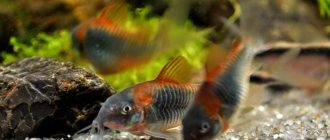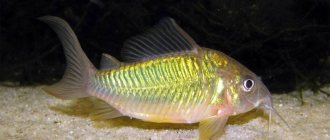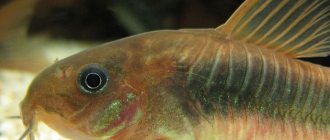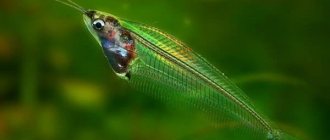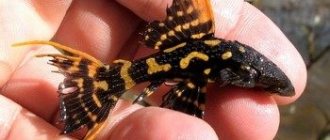Comes from South America. According to recent studies, this species has a wide distribution compared to most other members of the genus. The natural habitat covers large areas of the middle and upper Amazon River basin in Brazil, northeastern Bolivia, and the Paraguay-Parana River basin in Paraguay and northern Argentina. It is found in various biotopes, but prefers small tributaries, river backwaters, and wetlands. A typical biotope is a shallow, muddy pond with substrates of silt and mud.
Appearance and gender differences
Corydoras dwarf has a stocky, translucent body that is slightly elongated and slightly laterally compressed. Along the tanks there are two rows of bone plates that protect the fish from predators. The abdomen is straight. Lower mouth. There are two pairs of antennae around the mouth. The dorsal (with a spiny ray) and ventral fins are well developed, the caudal fin is two-lobed. Body color can vary from golden yellow to olive. A horizontal dark stripe runs through the entire body, ending in a diamond-shaped spot. All fins are gray in color. Sexual differences: the male is smaller than the female, the dorsal fin is pointed at the end, the female has a rounded dorsal fin. A female ready for spawning has a convex abdomen. The length of the dwarf corydoras grows up to 3 cm.
Feeding
Corydoras fish are absolutely unpretentious in their diet and are omnivorous; they eat everything that has fallen to the bottom and are real cleaners of the tank, as they free it from parts of dead plants and fragments of the bodies of dead inhabitants.
In addition, you should feed catfish with ready-made dry granular mixtures (for bottom feeding), live and frozen food - tubifex, bloodworms, daphnia, coretra, Artemia nauplii, earthworms.
Don’t forget about tablets with spirulina; occasionally you can pamper your pets with mashed egg yolk and slices of fresh cucumber. If there is a lack of plant components in the diet, Carapaceans can significantly damage aquatic plants.
Conditions of detention
The sparrow catfish is a schooling and peaceful fish. It is better to keep a flock of at least 10 individuals, with a predominance of males. They stay in the middle layers of water and spend very little time at the bottom. The aquarium can be either general or specific, with a length of at least 40 cm. The aquarium must have various shelters (grottoes, stones, driftwood), which are a favorite resting place and thickets of aquarium plants planted along the walls of the aquarium. We can recommend any small, peace-loving aquarium fish as neighbors. Rolled river sand, fine gravel and rounded stones are used as soil. Since these catfish have additional intestinal respiration, it is necessary to leave access to the surface of the water open. Optimal water parameters for keeping: hardness 5-15°, pH 6.5-7.2, temperature 21-25 °C. Aeration, filtration and weekly water changes of up to 20% of the aquarium volume are required. It feeds on live, plant foods, as well as substitutes.
Sparrow catfish or dwarf corydoras (Corydoras hastatus)
Sparrow catfish or dwarf corydoras (Corydoras hastatus) is an amazing small fish (3 cm long) belonging to the Callichthidae or Armored catfish family. This representative can be found in nature in the reservoirs of South America and tributaries of the Amazon River. Despite the fact that this tiny fish appeared in our country not so long ago, it has already gained wide popularity among lovers of exotic pets. And all this thanks to its unusual appearance.
Appearance
The dwarf corydoras is a very active and peaceful fish. Basically, these fish swim in schools and get along well with other fish. As for keeping them, a small and densely planted aquarium suits them perfectly. Throughout the day, the fish is quite active, and during rest it prefers to hide in the thickets of plants.
Despite its small size, the sparrow catfish has a strong body, which is slightly elongated in length and slightly compressed from the sides. On the sides you can see bone plates, which are arranged in two rows. They have a protective function, that is, they allow the catfish to defend itself from various predators. There is also a dark stripe that runs horizontally across the body and ends in a diamond-shaped spot. There are small antennae around the mouth. The fish has well-developed fins, they are gray in color. The pointed shape of the dorsal fin distinguishes the male from the female; in her it is more rounded. The pectoral fin is very sharp and resembles a ray. The male, when compared with the female, is much smaller and slimmer. As for color, the fish is either golden or bright yellow.
How to properly keep this fish?
Sparrow catfish likes to be in a school, so it is best to buy several individuals, where males predominate. Catfish prefer to stay in the middle layers of water than at the bottom of the aquarium. When choosing an aquarium, you need to take into account its length (at least 40 cm), it should be well lit and equipped with various rounded stones and driftwood. The fish’s favorite resting place is thickets of plants that need to be planted along the walls of the aquarium. Since the sparrow catfish is quite friendly, you can safely add other small species of fish to it.
Fine sand is ideal as a soil. Water parameters: hardness 5−15°, pH 6.0−7.0 and temperature from 18 to 27 °C. Be sure to change the water every week (20% of the aquarium volume), filter it and aerate it.
The dwarf corydoras is not particularly picky about food. Live and plant food, as well as various substitutes, are excellent for complete nutrition. It is thanks to a balanced and varied diet that the fish will always be in good shape.
Despite the simplicity of keeping this representative, there are some nuances that you need to know for the successful existence of this underwater inhabitant at home. Corydoras hastatus has gill and intestinal respiration. Therefore, it is extremely necessary for the fish to have constant access to the surface of the water so that it can take a breath of air. Therefore, the aquarium should always be open. Make sure that there are no sharp objects in the aquarium, as the catfish likes to dig in the ground in search of food and can easily get hurt.
How does it reproduce?
Sexual maturity of the dwarf corydoras occurs at approximately 10 months. The arched abdomen of the female is a sign that she is ready to spawn. The male pursues the female for a long time. Having caught up with her, he emits a cloud of milk. She takes the male's milk into her mouth and begins to actively spawn. The eggs are very sticky and easily stick to plant leaves or aquarium glass. The incubation period lasts 4−8 days.
Breeding
Corydoras dwarf sexual maturity at the age of 7-10 months. Spawning can take place both in a general aquarium and in a spawning tank with a volume of 40 liters or more. Water parameters: hardness 5-10°, pH 6.5-7.2, temperature 24-26°C. Aeration is needed. For breeding, a group of fish with a predominance of males (twice as many males) is selected, which are seated before spawning and fed well with live food for a week. Spawning is stimulated by frequent water changes. The spawning process lasts several hours. At the beginning, the males actively chase the female, after which the female takes the male’s milk into her mouth and lays eggs, gluing them with the help of the male’s milk to a well-lit place on the leaves of plants or glass. The female's productivity is up to 80 eggs. After spawning, the spawners are removed or the substrate with eggs is transferred to an incubator (the eggs can be carefully removed from the glass with a razor blade). The incubation period lasts from 4 to 8 days. 2-3 days after hatching, the fry begin to feed and swim. Starter food: live dust.
Liked? Share with your friends!
Social buttons for Joomla
Description
Adults rarely grow more than 3 cm. It is sometimes confused with Corydoras Pygmy due to their modest size, although they are otherwise markedly different. In the body shape of the Sparrow Catfish, a small hump is visible under the dorsal fin. The color is gray. Depending on the lighting, silver or emerald tints may appear. A characteristic feature of the species is the color pattern on the tail, consisting of a dark spot framed by white stripes.
Brief information:
- Aquarium volume - from 40 liters.
- Temperature - 20–26°C
- pH value – 6.0–7.5
- Water hardness - soft (1–12 dGH)
- Substrate type - sand or gravel
- Lighting – moderate or bright
- Brackish water - no
- Water movement is weak
- The size of the fish is about 3 cm.
- Food - any sinking food
- Temperament - peaceful
- Keeping a group of 4–6 fish
Diseases and prevention
Corydoras are real long-livers of the aquarium. With proper care, they can live more than 10 or even 15 years. But with prolonged and severe violation of water parameters, they suffer from many diseases, which include:
- Fungal infections. Most often this is fin rot. In this case, the plumage takes on a grayish “dirty” appearance and begins to collapse and rot. Sick individuals should be given baths with a weak solution of potassium permanganate or Furacilin. Salt ones are strictly prohibited. Pets should also be treated by adding Levomycetin and Bicillin-5 to the water.
- Parasitic diseases. This, for example, is such a common disease as ichthyophthyriosis (semolina), when the body of the fish becomes covered with a rash that looks like pieces of cotton wool. Adding a solution of Malachite green and Methylene blue to the container will help.
- Invasive pathologies. There are also cases of helminthiasis in catfish. Signs of the disease are compression of the fin plumage, the appearance of red spots on the body, decreased appetite, lethargy or excessive agitation, scratching on the ground. Levamisole hydrochloride or other anthelmintics for fish should be used for treatment. Most often, parasites are introduced with low-quality food, but they can also be transmitted from new infected individuals. Therefore, you should definitely let them through the quarantine.
- Bacterial infections. These are severe lesions that most often occur as a result of a weakened pet’s immune system. For example, aeromonosis, white skin, columnaris, lepidorthrosis, tuberculosis. Antibiotics are used for treatment and consultation with a competent veterinarian-ichthyologist is required.
- Toxic nitrate poisoning. Corydoras is capable of staying in polluted water for a long time, but even this unpretentious pet can be poisoned if the concentration of ammonia and nitrites in the water significantly exceeds. At the same time, the fish lies on the bottom on its side and breathes heavily. You should immediately transplant it into a container of clean water, clean out and restart the main tank.
Origin
In nature, miniature corydoras are found in various habitats, both in “black” waters and in clear ones, over a fairly wide area, from Venezuela and Colombia, in Peru, Ecuador and western and southern Brazil, in Paraguay and the Pantanal. Habitats may change during the wet and dry seasons. They are usually found on a sandy or gravel-covered bottom, but they also live in places where the bottom is covered with fallen leaves, in places where forests are flooded. This means that pygmy corydoras are very unpretentious and easily adaptable.
Area
Corydoras species are distributed in South America, where they are found east of the Andes to the Atlantic coast, from Trinidad to the Rio de la Plata basin in northern Argentina.
Corydoras are places of distribution.
Representatives of the genus inhabit the basins of the Amazon, Paraguay, Orinoco and many other rivers.
Corydoras habitats.
They usually live in silted, slow-flowing and stagnant bodies of water, mainly near the bottom and feed on benthic organisms.
Behavior and Compatibility
Most species prefer to be in groups.
Corydoras are different species in the aquarium.
These fish are quite easy to keep, they are peaceful, hardy, active and interesting. From time to time they rush to the surface, momentarily sticking their mouth above the water to “breathe” air. This behavior is completely normal and is not a sign that there is anything wrong with the fish.
Speckled catfish / Common catfish (Corydoras paleatus) Jenyns, 1842
Speckled catfish (Corydoras paleatus) is a representative of the genus.
The most common Corydoras in aquarium farming.
They inhabit the southeastern part of Brazil. Length up to 7 cm. Body from olive-brown to olive-green, with blackish spots and small specks of varying sizes on the back and side. The fins are gray with black spots and streaks. The male is smaller and slimmer than the female. There is a red-eyed albino form with pink body coloring. Water: 18-24° C, dH 5-25°, pH 6-8. In a spawning aquarium, water dH 5-15°, pH 6-7.4 is desirable. The female lays up to 200 eggs on leaves and hard objects. The incubation period is 5-14 days, the fry swim in 1-2 days. Sexual maturity 6-8 months.
